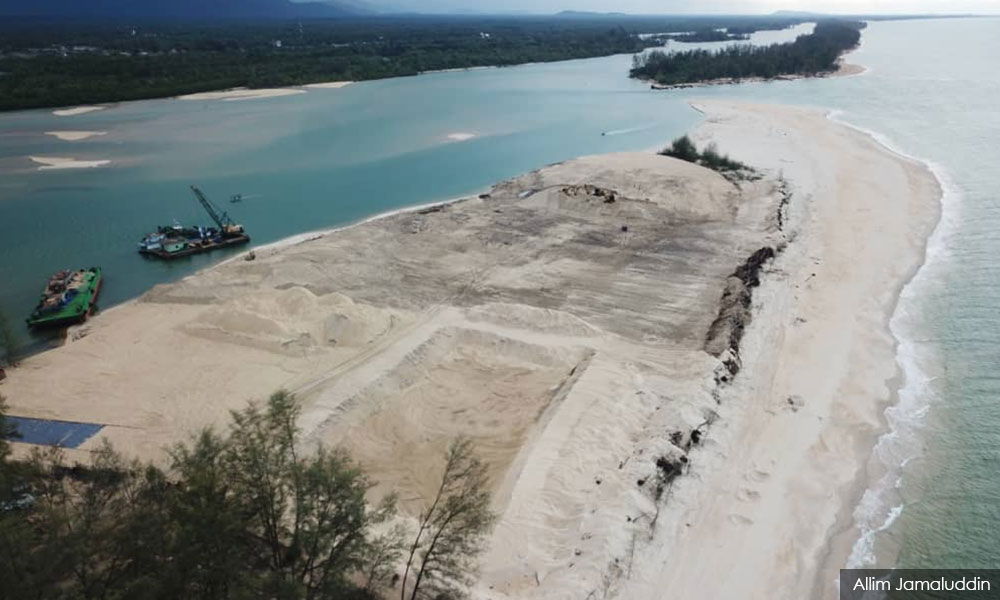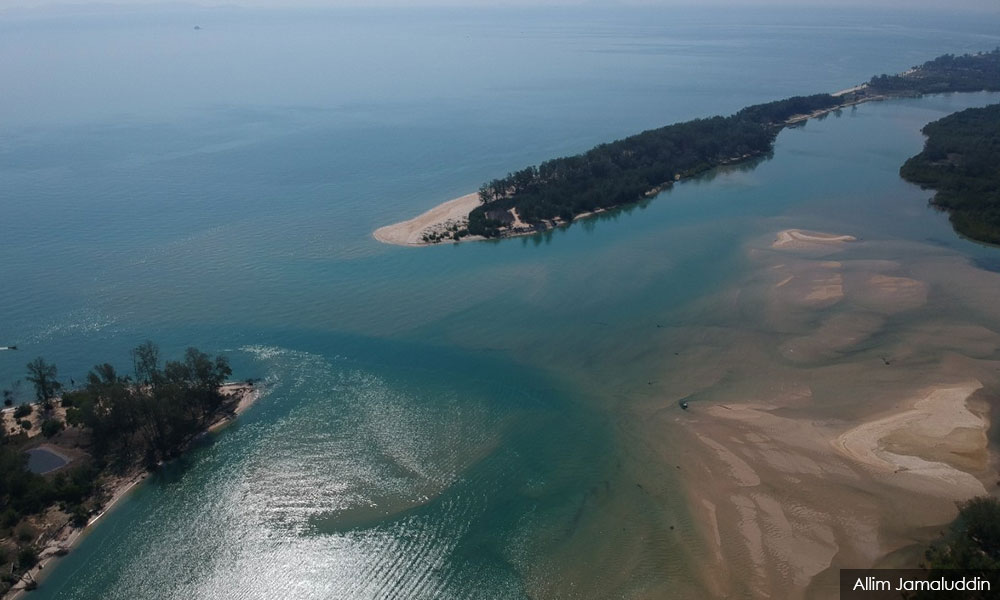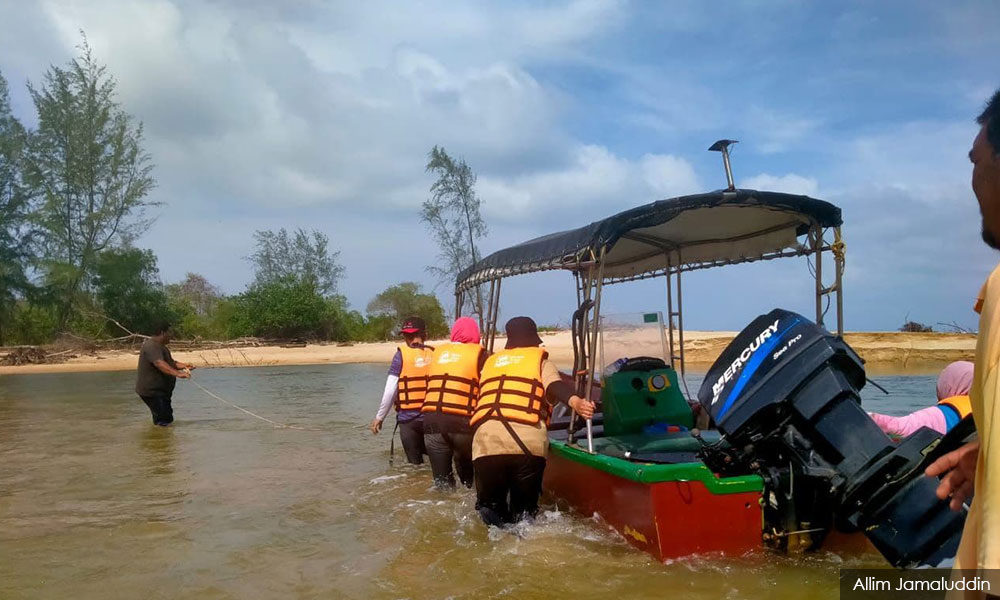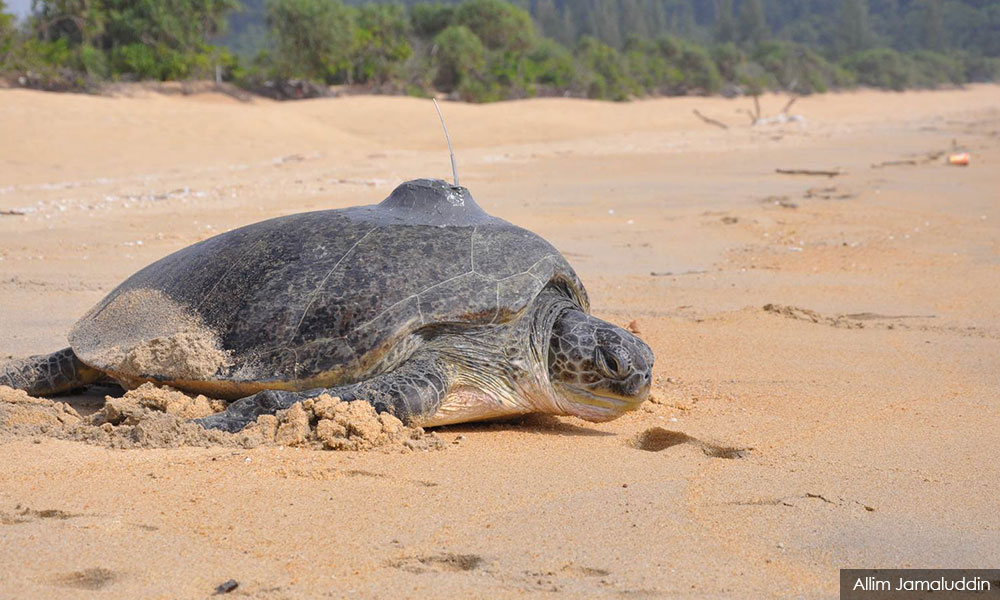In a twist of irony, a multimillion project said to deepen an estuary in Setiu, Terengganu, has worsened the situation, destroyed the ecosystem and further harmed local fisherfolk, stakeholders said.
The project, which was apparently meant to deepen the waters at the estuary and make it easier for fisherfolk to reach open water, led to the riverbank's erosion.
At the same time, the sand dredged from the river there is being sold overseas, deepening the pockets of the company, royal-linked M & Z Production Industry Sdn Bhd, instead of the estuary as intended.
A visit to the site in January saw fisherfolk and locals having to painstakingly find safer routes to shore, as more and more newly-formed sandbanks exist in the middle of the river mouth, especially after the monsoon season.
"This project did not deepen the estuary at all. They dug up sand but not in the area where we were facing difficulty reaching the sea.
"They only dredged up sand for their profits and made things harder for us," a fisherman in Kampung Mangkok, who only wants to be known as Pok Ngah, told the writer.
"Now, it is even harder to pass through the estuary. It is shallower, and the waves are stronger during low tide, so we cannot pass through.
"We are unable to go to Pengkalan Gelap to search for clams, like before, even though this project (which is supposed to make things better) has gone on for about a year," he said.
Locals feel misled
The existence of sandbanks in the middle of the river mouth has made life riskier for the local fisherfolk because the waves would break at the sandbank, causing choppier conditions for the small boats
Pok Ngah’s views contradict that of Omar Ismail, the chairperson of the local fishermen's association, who last June said the sand mining project helped fisherfolk, who no longer need to wait for the tide to come in to head out to sea.
Besides that, it was observed that boats had to navigate further around to avoid hitting large pipes and sand dredgers.
At the same time, the sand dredged created mounds, likening the area to sand dunes, eroding the river banks and causing trees and plants to fall into the river.

A recent survey funded by local environment group Ecoswed found that out of 30 locals surveyed, more than half were unaware that the project was to mine for sand.
The locals said they were only told that the project was to deepen the estuary but did not know that the sand dredged would be taken away and sold.
A fisherman, who only wanted to be known as Abang Man, felt the authorities were not upfront about the project's real purpose.
"Not many of us knew the sand would be sold and also exported. They only said they were deepening the estuary when the project was officiated. That's what it said on the banner.
"But in fact, the sand dredged is sold (overseas), so this is a two in one project," he said.
Loss of time, income and lives
This is not the first time sand mining has worsened conditions at estuaries and imperilled the fisherfolk in Terengganu.
In 2018, it was reported that sand mining, purportedly with the aim of deepening the estuary in Sungai Merang, had made the estuary shallower and smaller.
Fisherfolk, who had hoped the project would help with their woes, said they had to sell their wooden boats and replace them with fibreglass boats, which could better withstand the choppier waters.
Even so, they would often have to push their boats onshore because of the sandbanks that have formed as a result of sand mining.
Boats bringing tourists to Pulau Redang also faced difficulties that affected livelihoods, a local publication, Berita Online, reported.

The issue of shallow estuaries first emerged in the north of Terengganu 15 years ago, including in Kuala Dungun in Dungun, Kuala Merchang in Marang, Kuala Ibai in Kuala Terengganu and in Kuala Merang and Kuala Baru Setiu in Setiu.
Since then, the fisherfolk have reported having to spend the night in their boats while waiting for the tide to come in so they can reach the shore -something they never faced before.
It can also be fatal.
From 2013 to 2019, six boats were wrecked at Sungai Dungun when trying to pass through choppy waters caused by waves breaking at the newly-formed sandbanks. Three died in the wrecks, five were missing, and 13 were rescued.
Disrupting the flow and how the waves break
Universiti Malaysia Terengganu hydrology expert Edlic Sathiamurthy said sand mining at estuaries worsens conditions because it changes the flow from the river and how the waves break.
"When you disrupt this natural flow, it will change the way the sediments travel to the beach. This causes more sedimentation in the lagoon and estuary while at the same time taking away sedimentation from the beach.

"As a result, the lagoon and estuary will be shallow while the beach is eroded," he said.
Edlic said to avoid this, sand dredged up from the river must be replaced on the beach, instead of being taken out of the ecosystem and sold, like it is now.
Human ecology expert Jarina Mohd Jani said that human activities such as clearing forested areas upstream of Sungai Setiu could have also contributed to increasing the estuary's shallowness.
She said the river currents were not strong enough to bring all the sediments generated from upstream activity into the South China Sea.
When faced with the waves coming onto shore, the sediments formed banks at the estuary.
Critically endangered species
In Setiu, the sand mining project is also threatening critically endangered painted terrapins and green sea turtles, both species protected under the Wildlife Protection Act.
In April last year, Ecoswed Initiative, a marine ecology conservation group to which the writer belongs, raised concerns that the sand mining at Kuala Baru was destroying the casuarina trees on the banks.
In April last year, Ecoswed found rows of casuarina trees stretching 700 to 1,000 metres on the beach had been cut down.
This beach is a natural landing site for terrapins and green sea turtles.
The mining also takes place adjacent to the Setiu Wetland State Park, an environmentally sensitive area, Ecoswed observed.

However, M&Z Production Industry told Free Malaysia Today last year that the sand mining was to assist some 1,000 fisherfolk in the area and does not cause environmental harm.
The firm's executive director, Mohamed Farid Surani, told the news portal that its operations were backed by solid hydraulic research.
"So there is no question of damaging the environment," he said.
Mohamed added the state government approved the project and that it would replant the felled casuarina trees once the project had been completed.
Royal rebuke
However, last year, an inspection led by the Land and Mines Department and the Setiu Land Office found possible infringements under Section 425 of the National Land Code 1965, which deals with mining without lawful authority.
In a meeting on the matter last June, both agencies agreed to open an investigation paper on the matter.
Despite the concessionaire's royal links, the palace had in the same month also expressed unhappiness with the environmental impact of the project.
The Terengganu sultan's foundation, Sultan Mizan Royal Foundation, told the Setiu Wetlands Park committee that it is concerned that sand mining in the area is hurting the environment and hoped such projects do not happen again.

As such, the Terengganu State Economic Development Unit was tasked to seek a deposit of RM300,000 from the sand mining company.
The deposit was to be held by the Setiu Land Office, and returned once the area had been rehabilitated, the Setiu Wetlands Park committee meeting minutes states.
Since then, the state Department of Irrigation and Drainage (JPS) also informed the concessionaire that all works must stop by Dec 31, 2021, upon the expiry of the temporary operator licence.
This is to make way for an RM150 million government project to rehabilitate the Sungai Setiu estuary, which has long been on the cards.
However, the concessionaire sought an extension, arguing that it was difficult to mine during the monsoon period, issues shipping the sand overseas under the movement control order at the time and the high investments made for the project.
To avoid possible legal implications for the state, the final decision on the project is pending a meeting between the state government, Finance Ministry and the Environment Ministry.
ALLIM JAMALUDDIN is the founder of Wetland School of Setiu, a community-based wetland education & awareness centre in Terengganu and a part of Ecoswed Initiative, a group of volunteers aimed at empowering the local community at Tanah Bencah Setiu in ecotourism and wetland conservation.
This story was produced with the financial support of the European Union in the form of a grant from Internews Malaysia. Its contents are the sole responsibility of Internews and do not necessarily reflect the views of the European Union. - Mkini



No comments:
Post a Comment
Note: Only a member of this blog may post a comment.